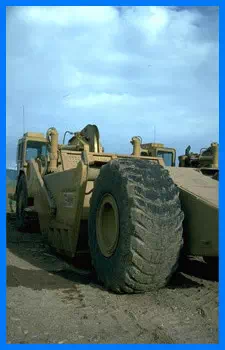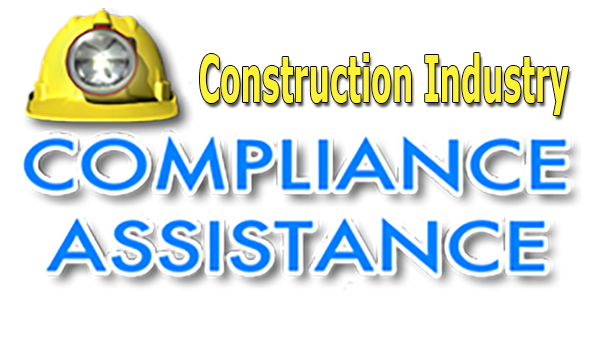
Diesel Engines/Anti-Idling
 Most
construction vehicles, such as earth moving equipment, are powered
by diesel engines. Diesel engines are also used frequently in other
kinds of equipment found at construction sites such as generators
and
compressors. Diesel exhaust contains tiny particles known as fine
particulate matter. Diesel engines are one of the largest sources
of fine particulate
matter, other than natural causes such as forest fires. Diesel
exhaust also contains ozone-forming nitrogen oxides and toxic air pollutants.
Fine particles and ozone pose serious public health problems. Exposure
to these pollutants causes lung damage and aggravates existing
respiratory
disease such as asthma.
Most
construction vehicles, such as earth moving equipment, are powered
by diesel engines. Diesel engines are also used frequently in other
kinds of equipment found at construction sites such as generators
and
compressors. Diesel exhaust contains tiny particles known as fine
particulate matter. Diesel engines are one of the largest sources
of fine particulate
matter, other than natural causes such as forest fires. Diesel
exhaust also contains ozone-forming nitrogen oxides and toxic air pollutants.
Fine particles and ozone pose serious public health problems. Exposure
to these pollutants causes lung damage and aggravates existing
respiratory
disease such as asthma.
On a national basis, the strategy for controlling air pollution from diesel engines involves low-pollution requirements for new diesel engines and rules covering the fuel used by these engines. EPA has issued emission standards for new, nonroad diesel engines, such as construction and farm equipment, and is working to strengthen these standards in the future. Also, low sulfur (500 ppm) and ultra low sulfur diesel (ULSD) fuel were phased in for nonroad, engines from 2007-2014. These fuel requirements, coupled with advanced emission control technologies, will decrease emissions from these engines by more than 90% (read more).
Diesel engines within existing equipment will not be subject to the new regulations, yet may remain in operation for another 25-30 years. Therefore, EPA and states are working to:
- Retrofit existing diesel vehicles with pollution controls (e.g., http://epa.gov/cleandiesel/verification)
- Implement emission testing programs for diesel vehicles.
- Create and implement anti-idling programs.
- Promote cleaner fuels like ultra-low sulfur diesel and compressed natural gas.
Some air districts regulate emissions from portable equipment that have spark ignition or diesel fired piston type internal combustion engines that may be used at constructions sites, including generators, pile drivers, compressors, welders, cranes, well drilling, etc. For example see Yolo-Solano Air Quality Management District. Check with your local air pollution control authority to find out if there are regulations that pertain to your equipment.
Anti-Idling Regulations
There are no federal regulations limiting truck idling. However, more than half of U.S. states and dozens of cities and counties have enacted idling laws or ordinances. Trucks operated in those states and local jurisdictions are covered by the regulations, including out-of-area vehicles that are in transit. For more information on anti-idling regulations, visit TERC Center - Engines Emissions. Also, the American Transportation Research Institute (ATRI) publishes a compendium of current idling regulations by state.
More Information on Diesel Engine Regulations:
Combustion Portal. Find the rules for stationary reciprocating internal combustion engines (RICE) such as those used for pumps and on-site generators.
Transportation Portal. Find the rules for diesel powered hauling trucks.
Nonroad Engines, Equipment, and Vehicles. EPA has adopted emission standards for nearly all types of nonroad engines, equipment, and vehicles. Find standards that apply to each of the categories.
Diesel Fuel. The cleaner diesel fuel program significantly reduces sulfur content, creating immediate health benefits, and allowing engine manufacturers to begin using advanced emissions control systems that further reduce harmful emissions. The diesel program regulations are located in 40 CFR Part 80 subpart I.
Cleaner Diesels: Low-Cost Ways to Reduce Emissions from Construction Equipment. Published in March 2007, documents a research project designed to study and identify low-cost ways to reduce emissions from non-road construction equipment. It reports on the costs and benefits of a number of these strategies/actions that may be taken by small companies (and medium or larger ones as well) in the Construction sector to reduce their emissions. Air pollution from diesel emissions is a public health concern that reaches every part of the country. The two main pollutants of concern in diesel exhaust that affect human health are nitrogen oxides (NOx) and particulate matter (PM). The Construction sector is a significant contributor to these emissions, creating 32 percent of all mobile source NOx emissions and 37 percent of PM emissions.
Emission Reduction Incentives for Off-Road Diesel Equipment Used in the Port and Construction Sectors. Published in May 2005, documents the development of incentives to reduce diesel emissions from off-road equipment used in the Port and Construction sectors. This report contributed to the EPA Clean Air Act Advisory Committee's Recommendations for Reducing Diesel Emissions.
